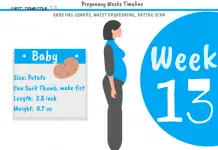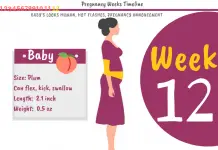Last time you went into the labor room pushing hard but got a C-section. Probably you resolved to never get pregnant again after C-section. But then as the memory faded, you got a positive pregnancy test! Pregnancy after C-section gives you hope to get off the disappointment last time. Now you don’t want to have stitches and are keen on getting a vaginal birth after C-section. But people are warning or even discouraging you about getting a VBAC.
Why?
The reason is not difficult to understand but may be exaggerated. If you had stitches last time and the incision was long and high up your uterus can rupture. That happens only when your fetus is bigger or you have some complications. Ironically, VBAC is actually a safer and better option compared to a second cesarean. If you have spontaneous labor before your due date then you must take a Trial Of Labor After Cesarean (TOLAC).

What is a VBAC?
Vaginal birth after C-section or VBAC is a normal delivery. When a woman who previously had a cesarean decides to have a natural birth she has to take TOLAC.
If the first delivery is cesarean can the second be normal? Not only first even if you had two caesareans you can still have a natural birth. The only condition is that you are healthy and have no uterine abnormality.
If you have the same reasons such as a genital herpes infection then you need a repeat cesarean.
What is a trial of labor after a cesarean?
Trial of labor after cesarean TOLAC refers to the attempt to undergo labor. Some women willingly opt for a cesarean to avoid suffering labor pain. In their case, they can try giving a natural birth for the second pregnancy.
TOLAC and VBAC are two steps of natural birth by a woman who had a previous C-section. Many women may try a TOLAC but not have a VBAC (Vaginal Birth After C-Section).
The terms sound heavy but they simply mean trying a natural birth after C-section with the hope of succeeding.
What are the risks of TOLAC?
The risks of TOLAC are same as that of VBAC. If you have the baby out after suffering a uterine scar rupture it will be a VBAC risk. In other cases, even after the rupture if you have to get a C-section then it would be a TOLAC risk. An unsuccessful TOLAC leads to a repeat C-section.
Even if you don’t have a VBAC there are Benefits of TOLAC. The oxytocin releasing during labor tones cervix. It also helps in lactation and bonding with your baby.
Don’t feel terrified the risk of having a uterine rupture is only 0.2%. The success rates of TOLAC are 60-80% leading to VBAC. Feel better and positive about it!
Can you give a natural birth after C-section?
A previous cesarean does not mean that you are incompetent to give birth vaginally. You can have a VBAC after 2 C-sections. There are many factors that affect the safety of vaginal delivery after cesarean. Your scar can rupture during labor because of the rapid and strong contractions.
If your baby is bigger in size or your pelvis is small then a VBAC is not safe for you. Similarly having a history of uterus surgery limits your possibility of a successful vaginal birth. Statically the success rates of VBAC of mothers who have had both C-section and vaginal birth are higher. The successful VBAC stories show that about 60-80% of women have got it right. You need to know some VBAC facts and tips before making your birth plan.
What are the risks of Vaginal birth after C-section?
There are many reasons for trying and not trying a VBAC. You need to consider all the risks of VBAC and consult your doctor about them.
Considering the intensity of VBAC risks you need to find out the right birth center or hospital which has necessary facilities. If you are planning on having a home birth after cesarean then you hire an expert doula for VBAC.
1) Risk of Uterine rupture due to VBAC
Only 1 in 100 mothers who have a low transverse incision have the risk of rupture of the uterus during VBAC. When a woman has a higher incision or T shaped scar her risk is higher.
2) Hysterectomy
If the rupture of the uterus is severe then you may need to get the uterus removed completely. The process of removing uterus surgically is hysterectomy and makes a woman infertile.
3) Fetus strain
Your baby can undergo strain due to the stress during labor. This increases the chance of pooping inside. Once the baby poops doctors have to immediately get it out.
4) Landing up with a more severe cesarean case
If things don’t go as your birth plan then the emergency situation can get worse. Perhaps what could happen with a normal incision now will need a T shaped or up-down longer cut.
5) Blood loss and blood clots
When you have a scar rupture a lot of uncontrolled bleeding. In that situation, if your placenta sticks to the bottom, surgical removal will cause excessive blood loss. There can be blood clots in different regions where supply cuts off. If you had anemia during pregnancy then you will not be able to withstand bleeding.
6) Damage to bladder
In extreme cases, the rupture can damage your bladder. The muscles of the uterus can damage permanently. When your bladder suffers injury, risks of infections and urinary incontinence arise.
All this happens when you don’t gauge the risks of VBAC properly. If you are healthier this time then you don’t have to worry about it much.
Factors to consider for having a VBAC
When talking to your doctor about natural birth after previous C-section you must consider these. What factors should you consider before a TOLAC?
1) Type of incision in the previous C-section
A previous low transverse incision is less risky and can sustain labor stress. There are other two kinds of incision namely low vertical and classical (high vertical). Both involve an up-down incision made at low and high positions respectively.
A longer high vertical scar is more likely to rupture. You must consider a repeat cesarean if you had a high vertical cut. There is two layered or single layer stitching after C-section. If you had a single layer stitching in previous C-section then you must not do a TOLAC.
2) Number of previous C-section and their reasons
If you have had 3 C-sections previously then think well before VBAC. The risks of repeat cesarean are higher. But after having many C-sections previously a VBAC can do more harm than good.
3) Pelvis size and baby’s size
A small pelvis size and a large baby is a combination that can cause uterus rupture. When the baby is bigger for your pelvis then the pressure transfers laterally. Your bladder can damage in that case.
4) Results of fetal non-stress test
A fetal non-stress test (NST) determines whether you can sustain the labor. Tests for VBAC include ultrasound and fetal nonstress test. Discussion of surgery history precedes everything when deciding if you can have a VBAC. During a fetal non-stress test, the doctor measures your baby’s heartbeat and movement after external stimuli. When the result is reactive and your baby is able to respond to stimuli, you can do a trial of labor.
5) Infections
Mother’s with infections such as genital herpes then you have to get a repeat cesarean. The infections that can pass to the baby during labor and delivery don’t allow a TOLAC.
6) Location of birth
If you are going to have a home birth after cesarean then your doctor may not encourage you. Birth centers have the highest success in VBAC. Some hospitals are not in favor of VBAC and notoriously will do a repeat cesarean. You will have to get an IV and there will be continuous fetal monitoring. If you don’t want that you need to talk about it with your birth provider.
7) Thickness of endometrial lining
If your uterus lining thickness is not enough then you are at higher risk of failed TOLAC. Your endometrial wall thickness must be more than 2.5mm.
8) Dystocia or hypotonic uterus
When your uterus becomes stiff or is not able to have contractions, labor stalls. Hypotonic uterus dysfunction arrest labor. Dystocia refers to a slowly progressing cervical dilation. When the cervical dilation is not enough even a smaller baby won’t be able to come out. Pelvic bones can open up and the baby’s head is soft enough to compress a bit. But unless the opening exists tearing is inescapable.
9) History of uterine surgeries
If you had any fibroids or endometrial surgery there can be internal scars. The rupturing of tissues internally will lead to hemorrhage.
10) Position of baby
The head first or head down position baby is favorable for a VBAC. When your baby is in breech or feet first position VBAC success is lower.
11) Whether you have real labor or induce labor?
Studies reveal that there are lesser successful VBAC when women have to induce labor. Artificial rupture of membranes poses the risk of infections. Labor induction poses the risk of uterine rupture. Even when labor began normally but stalled augmentation poses neatly equal risk.
12) Future pregnancies
Repeat cesarean risks such as placenta accreta, and hysterectomy impede multiple pregnancies. If you want to have more kids then do consider VBAC.
13) Obesity
Obese pregnant women have a fairly low vaginal birth after C-section success rate. The excess fat in the area impedes labor.
14) Preference for pain killers and epidurals
If you cannot withstand pain and are relying on taking an epidural or pain killers then you must rethink. During VBAC taking an epidural can make your senses numb. You might not be able to feel the start of uterus rupture. Some researches show that there is no such masking of pain by epidurals. Consult with your doctor about the medicines for pain during VBAC.
15) Age and any disorders
With increasing age of mother natural delivery has a risk anyway. Any disorders like anemia which reduce oxygen supply are risk factors for failed TOLAC.
Repeat C-section Risks
There are many benefits of vaginal birth such as early recovery, and less blood loss. The chances of getting an infection in the vagina after birth are less when you have a natural delivery. Repeat cesarean vs VBAC birth has many points to consider.
Repeat Cesarean Risks
- Risks of surgical procedures: Uterine rupture, blood loss, hysterectomy
- Longer recovery period and hospital stay: Quick recovery and shorter stay at the hospital, can do a home birth
- Risk of infections: No risk of infection due to VBAC but a subsequent C-section after failed VBAC can cause infections
- Respiratory problems in baby: Baby’s lungs gradually begin working during labor
- Safe when you plan to not have more pregnancies: Better option is future pregnancies intended
Can you have a natural birth after 2 c-sections?
YES! If both of your previous cesarean surgeries were low incision then you can still birth plan for VBAC. If you are willing to bear the labor pain then you must do the trial of labor. You are not alone when you think about natural birth after 2 C-sections.
How to have a successful Vaginal Birth After C-Section (VBAC) delivery?
Tips for normal delivery after C-section include preparations beforehand. Here are a few tips for successful VBAC:
- Space your pregnancies
- Consider not taking epidurals or pain killers
- Do perineal massage and kegel exercises
- Eat well and stay healthy
- Keep some snacks along to help you during passive phases between labor
- Maintain your blood pressure at the normal level
- Prevent excess weight gain
- Cut down stress and don’t get anxious even when things don’t do like your plan
- Reach out to find an expert doctor
How long after a C-section can you have a VBAC?
When you get pregnant in 18 months or less after a cesarean there is a risk of repeat C-section. You must wait for more than 18 months to get pregnant for a VBAC.
How to prepare the body for VBAC?
More than anything else you have to decide it for yourself and be determined. Forget the previous experience and start afresh for getting a VBAC. You must do the following to prepare for VBAC:
- Hire a pro VBAC midwife or doula.
- Visit a Chiropractor for pelvic alignment and doing other exercises to prepare for VBAC.
- Find the right birth center or hospital that has a high success rate of VBAC.
- Do squats and kegel exercises to prepare your vagina.
- Have a supportive birth partner.
How to increase chances of VBAC?
Certain labor positions such as squatting can increase the chances of successful VBAC. Preparing your body for VBAC following the tips will also help.
Where can you get a VBAC?
You can get a VBAC at a birth center or hospital. Make sure that your doctor is able to handle such cases. The staff and birth center should be open on weekends and holidays. Home birth after cesarean is a possibility if your doula knows how to deal with complications of VBAC.
What are the benefits of VBAC?
VBAC pros and cons comparison is not uniform for all. The pros of vaginal birth after C-section depend on your condition. A quick recovery and less chance of infections and blood loss make VBAC a better choice.
A VBAC will help you come out of any sense of failures from previous experience. It will make you an active partner in delivering your baby.
- Less blood loss
- Safe for having future pregnancies
- Lower chance of infections
- Newborn has better resilience
- Hormones will have a normal rise and fall
- Quick recovery
- No abdominal scars, episiotomy
VBAC Facts
Read some facts about VBAC to understand it better.
- VBAC has a higher success rate if you had a previous vaginal delivery apart from C-section
- VBAC tones your cervix and helps baby to have a strong respiratory system
- Most successful VBAC stories mention the spontaneous onset of labor
- Younger mothers have a successful VBAC delivery
- You can have a VBAC even after 2 c-sections
Vaginal birth after C-section recovery takes 2 days in the hospital. With proper diet and care, you will heal soon!



![First Trimester Of Pregnancy: Weeks 1 To 13 First Trimester [Week 1- Week 13 Overview]](https://www.pregnanteve.com/wp-content/uploads/2019/07/first-trimester-of-pregnancy-218x150.jpg)





